Setting off with their buckets and spades, French families talk about going to ‘la mer’, the Mediterranean Sea, or ‘l océan’, the Atlantic. Two utterly spectacular and utterly different coasts. The wine-dark waters of the Med look eastward, towards the old world, olive trees and palms. To the south, an older world, camels, lions and elephants.
‘L’océan’ looks west. It rolls out towards the New World, immense and ever-changing. Here sky and water join in a spellbinding duet, offering up the entire palette of colours, dense and translucent, brilliant and dark. In the space of a heartbeat the colours fade, shadows fall from the sky, the wind freshens and stormy greys and greens whip in from the horizon like furies.
It’s the same ocean that Herman Melville wrote about in “Moby Dick”, one of the greatest books ever written, and surely the greatest book about the sea. In the nineteenth century Ishmael and Queequeg set off from Nantucket in the Pequod to hunt the leviathans of the deep. Thousands of miles to the east, the Basques had started the hunt for the whale seven or more centuries earlier.
If you imagine a map of modern-day France and Spain, the coast of the Basque country, Euskal Herria, runs along the Bay of Biscay, starting in the bottom left of France, straddling the Pyrenees and continuing into the top right corner of Spain. It’s a region that is curiously ‘undiscovered’. Ask any non-surfing, non-French person to name famous French towns and it’s pretty certain that Bayonne, St-Jean-de-Luz, and Hendaye won’t be on the list. Biarritz is perhaps the exception, but it too is relatively unknown compared to Cannes, Nice, Saint-Tropez and other Mediterranean resorts.
This beautiful part of Europe is home to some of the most mysterious people in the world. Where did the Basques come from? What were the origins of their language, Euskera? Nobody knows. But they were well-established when the Romans arrived in Gaul, and there is evidence to suggest they date back to pre-historic times. And one thing is sure, they are still there today, their culture intact. To hear a Basque break into song a cappella sends shivers down the spine. Watch a game of cesta punta and you’ll be out of your seat and shouting in seconds. Put on your dancing espadrilles and plunge into the effervescence of the feria of Bayonne.
Of the many spectacular beaches in the region the one that is most special for me is la grande plage of Biarritz, partly because it holds a lot of happy memories, partly because it is simply stunning.
‘Reine des plages, plage des rois.’ It acquired its famous title in the 19th century when the Empress Eugénie fell in love with the place, and the Emperor, Napoleon III, in love with his Empress, built her a summer palace in 1854 from which she could gaze out on this ‘queen of beaches’.
From this romantic gesture, a glittering era was launched. Crowned heads from all over Europe joined the Imperial court. Biarritz became ‘the beach of kings’, as aristocratic toes were dipped in the vivifying waters. The Imperial era was followed by the Belle Epoque, later, it was the turn of the jet set and Hollywood stars; Frank Sinatra, Rita Hayworth and Ava Gardner all visited. Today, Biarritz is still famous as a spa, with two prestigious establishments offering thalassothérapie, seawater cures and other luxury treatments for a distinguished and wealthy clientele. And the other famous beach of Biarritz, the Plage de la Côte Basque, has become a mecca for surfers from all over the world, being voted No. 1 beach in France on TripAdvisor 2014.
In high season, the town’s population is as mixed as its architecture. Walking down to the seafront you pass buildings with Basque gables, gothic turrets, Greek pediments and onion domes. Sitting at the Café de la Grande Plage you rub shoulders with chic, small-dog-accessorised ladies, families just off the beach covered in sand, silver-haired gentlemen reading Le Figaro and surfer dudes, one eye on the waves and the other on beautiful Basque maidens putting the Girl from Ipanema in the shade.
The ambience is relaxed and good-humoured, tattoos and piercings side by side with Cartier watches. One magical summer evening many years ago I was with friends at the Port des Pêcheurs. We sat at an oilcloth-covered table waiting for our order of sardines, discovering a white wine which lifted a layer of enamel off the teeth with every sip. The cook was sweating over an oil-drum barbecue, squirting jets of vinegar onto the sizzling fish. Clouds of pungent blue smoke rose into the air. Suddenly a murmur ran through the crowd. ‘Look, it’s her, it’s Catherine!’ Yes, it was the divine Deneuve herself, with her golden mane and sculpted face. And who was that holding out her chair? Bite your thumbs ladies. It was the equally divine Marcello Mastroianni. But there were no popping flashbulbs, no screaming fans to spoil the evening for the Divine Duo. The laid-back crowd smiled, clapped, then got on with the serious business of tackling those wonderful blackened sardines.
But back to the queen of beaches and its beautiful curve.
I’ve always been a sucker for The Curve. In the pink city of Toulouse where I used to live it was hard to take a step without coming face to face with this lovely flowing variation on the straight line. Curving streets, curved facades, the bow-front of a window where, in times past, ladies of the night used to sit and beckon. Caryatids with curved arms holding up balconies. Forget the impressive grids of Barcelona and New York. The Curve’s the thing, and the Bay of Biarritz has a beauty, an understated, widely graceful curve, a crinoline of a curve. Eugénie could behold it from her palace, set on the northern side of the bay and modern day diners can admire it from the semi-circular sweep of windows in the dining room of the Hôtel du Palais. Opposite, on the southern side is the Casino Bellevue, dazzlingly white, its beautiful rotunda jutting out like a prow towards the water. Between these two iconic buildings the Casino Municipal strikes a pleasing contrast with the straight lines of its Art Deco facade.
That great Romantic writer, Victor Hugo, on his travels through southwest France in 1843, wrote about the charms of Biarritz: ‘…one of the places I would choose ‘for the pleasure of my eyes…’; ‘…I know of no place more charming or more magnificent…’
He was not just taken with the geology. He describes the bathing habits of the local maidens, laughing as they plunged into the sea in flimsy shifts. One day, walking along the beach he came across one of these young ladies, singing as she swam in a rocky creek, and was reminded of Ulysses listening to the Sirens. (Victor Hugo, “Ecritures: Alpes et Pyrenées”)
But he was pessimistic about the future of this unspoilt village and its coastline:
‘I fear only one thing–that (Biarritz) becomes fashionable. Already people are arriving from Madrid, soon there will be others, from Paris…’
Eh oui, Victor. But, as they say in the Michelin guides, it’s still worth the detour.
Go out of season if you can. Wander through the streets, raise your eyes to the rooftops. Stop off at the market and buy some local ham. Make your way to the port des pêcheurs and enjoy an aperitif and pintxos, delicious Basque tapas.
But make sure you leave time to give yourself the best treat of all. Find a railing to lean on, or a bench to sit on, or a cliff to climb, and take your place alongside all those other contemplative ‘water-gazers’, who
‘…posted like silent sentinels all around the town, stand…fixed in ocean reveries.’ (Herman Melville, “Moby Dick”)
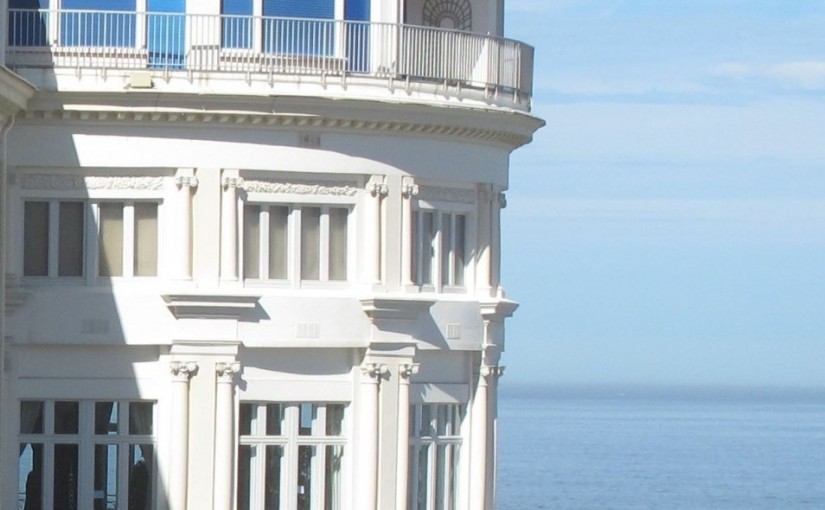
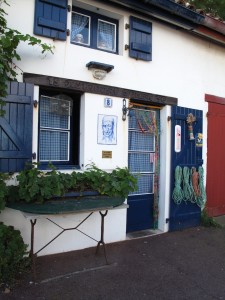
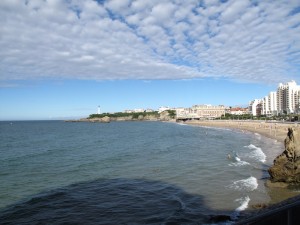
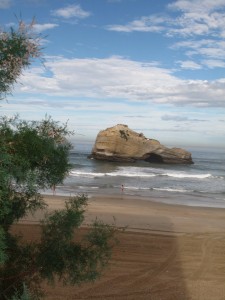
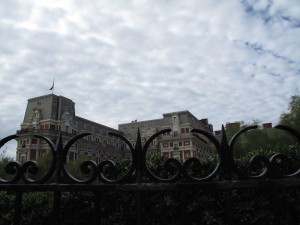
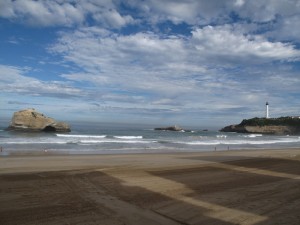
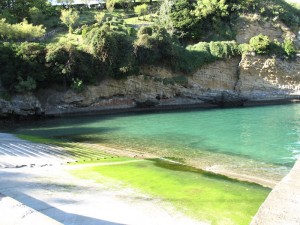
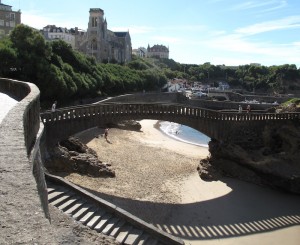
Dear Laurette,
So glad to hear about your blog! I bought “Biarritz Passion” on amazon last year in March and loved it. Your writing is wonderful indeed and I am really looking forward for “Hot Basque”!
Hope it’s coming out soon!…
Cheers…………….
Dear Toto
Thank you for that kind message! I’m sure you know Biarritz?? Hot Basque has the same setting and you’ll recognise some of the characters, but there’s a new heroine… all I’ll say is that she’s a sexy Irish redhead who meets her match in a very hot Basque. Will the recipe be a success?? Aha! Stay tuned…
Cheers, santé and chin chin!
Laurette
Biarritz is wonderful indeed!
So is your writing.
When will you publish ‘Hot Basque’?
Thank you Harold. Don’t know how Biarritz is faring at the moment, down here in south west France we have several inches of snow!!! Excellent excuse to stay inside and work on Hot Basque … 🙂
Loved “Biarritz Passion”.
Looking very much forward to “Hot Basque”.
Thank you Laurette Long!
Hi Gilbert
Glad you enjoyed the first book. “Hot Basque” is simmering, not quite cooked yet, if you’ve got a hotline to The Muse, give her a nudge…
Laurette